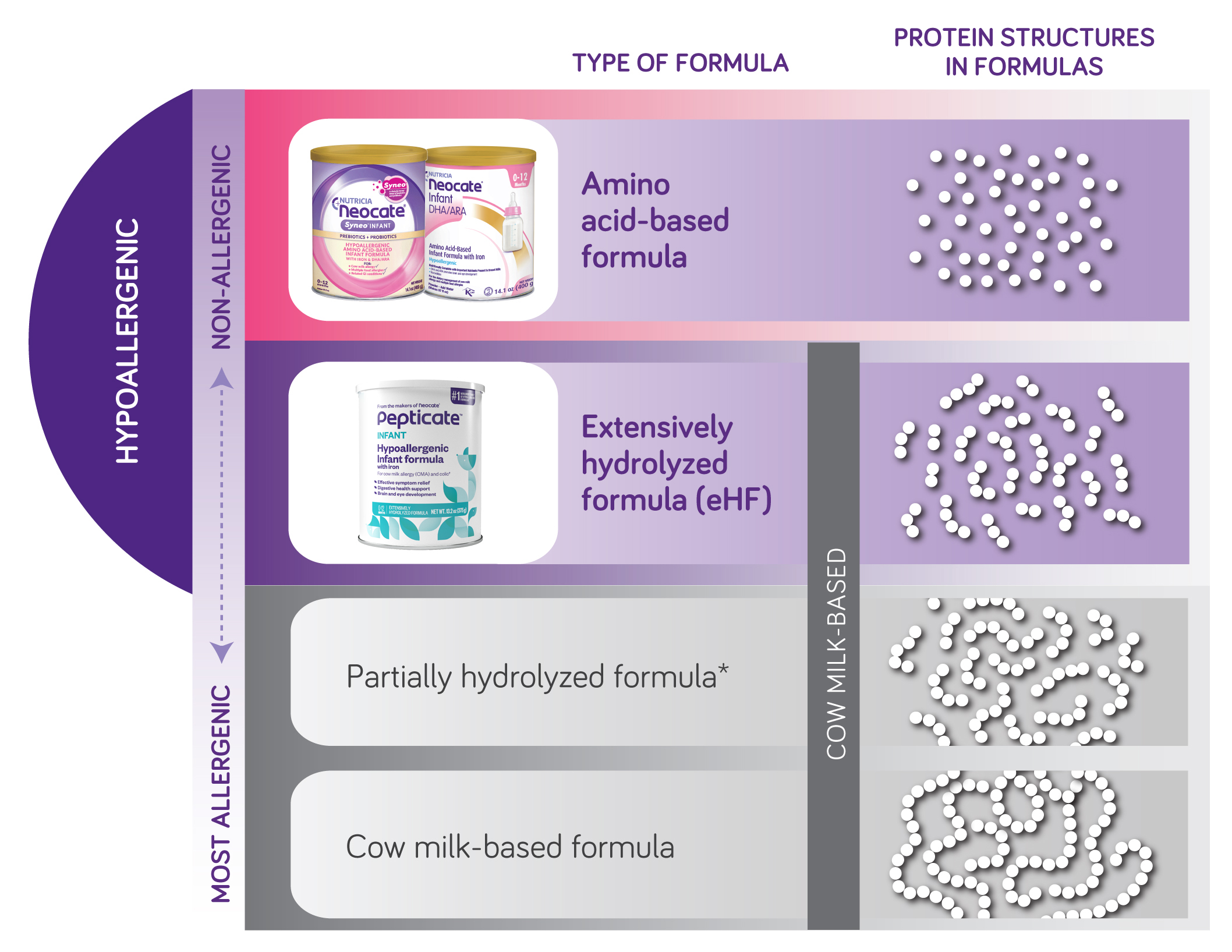 You may have heard about Pepticate™ and Neocate® infant formulas and wondered what’s the difference between them. We’re here to answer this question!
You may have heard about Pepticate™ and Neocate® infant formulas and wondered what’s the difference between them. We’re here to answer this question!
Please note that when we refer to “Neocate infant formulas” in this blog post, this includes both Neocate® Syneo® Infant and Neocate® Infant DHA/ARA.
How are Pepticate and Neocate similar?
First, let’s discuss how Pepticate and Neocate infant formulas are similar.
- Both are types of nutritionally complete, hypoallergenic infant formulas for children ages 0-12 months.
- Both formulas have been clinically shown to be hypoallergenic (meeting the criteria established by the American Academy of Pediatrics for hypoallergenicity) and to support age-appropriate growth.
- Both are indicated for the management of cow milk allergy.
What’s the difference between Pepticate and Neocate?
Although both Pepticate and Neocate are hypoallergenic formulas for the management of cow milk allergy, they belong to two different categories of hypoallergenic formulas. Pepticate is an “extensively hydrolyzed formula” (eHF) whereas Neocate is an “amino acid-based formula” (AAF). The key difference is in the protein component of the formulas, which make them appropriate for different degrees of cow milk allergy severity. Pepticate is indicated for mild to moderate cow milk allergy, whereas Neocate is indicated for more severe cow milk allergy, multiple food allergies, or other gastrointestinal and allergic conditions.
What is an Extensively Hydrolyzed Formula?
The first thing to understand is that food proteins, including cow milk protein, are made up of long chains of amino acids (amino acids are sometimes referred to as the “building blocks” of proteins). The second thing to understand is that the symptoms of cow milk allergy are caused by the proteins found in cow milk (whey and/or casein).
An extensively hydrolyzed formula or eHF is a formula where the allergy-triggering proteins in cow milk (remember proteins are long chains of amino acids) have been hydrolyzed (broken down) into smaller chains of amino acids called “short-chain peptides” to be well tolerated by most infants with cow milk protein allergy.
In Pepticate’s case, the protein component of the formula comes from extensively hydrolyzed (broken down) whey proteins. Sometimes parents see the first ingredient listed for Pepticate (Whey Protein Hydrolysate) and are confused how this formula can be hypoallergenic if it contains whey protein. The word “hydrolysate” there is describing how the whey protein has been broken down.
What is an Amino Acid-Based Formula?
An amino acid-based formula does not contain any whole proteins or peptides. The protein source in these formulas comes from 100% free amino acids (the building blocks of protein and peptides). Amino acid-based formulas, like Neocate, are considered the most hypoallergenic type of formula. Children who do not tolerate an extensively hydrolyzed formula may need an amino acid-based formula and should discuss this with their healthcare provider.
Visualizing the Difference Between Extensively Hydrolyzed and Amino Acid-Based Formulas
To help you visualize the difference between extensively hydrolyzed formulas and amino acid-based formulas, picture a pearl necklace to represent regular cow milk proteins, where the pearls represent amino acids. The process of “extensively hydrolyzing” formula is like cutting the long chain of pearls into very short chains of pearls, which represent short chain peptides, the protein source in Pepticate. If you start with individual pearls (no chains), then you have an idea of free amino acids, the protein source in Neocate. The image below shows how the protein structure varies between regular cow milk-based formulas, partially hydrolyzed formulas, extensively hydrolyzed formulas, and amino acid-based formulas. Both amino acid-based formulas and extensively hydrolyzed formulas are considered hypoallergenic; Partially hydrolyzed formulas and standard milk-based formulas are not hypoallergenic.

So, which one is right for my child, Pepticate or Neocate?
This is something important to discuss with your child’s healthcare provider because it depends on the type and severity of your child’s food allergies. In general, Pepticate may be indicated for mild to moderate cases of cow milk allergy whereas Neocate may be indicated for more severe cases of cow milk allergy, multiple food allergies, or other gastrointestinal and allergic conditions.
Children with more severe food allergies who require an amino acid-based formula may not tolerate an extensively hydrolyzed formula. Therefore, if your child is using Neocate or another amino acid-based formula, you should not substitute with Pepticate or another extensively hydrolyzed formula, unless directed by your child’s healthcare provider.
Still have questions?
We hope this helps to answer your questions about the differences between Pepticate and Neocate but if you have further questions, please reach out to our Nutrition Services team at 1-800-365-7354, Option 3. We are available Monday-Friday, 8:30 AM – 5 PM, ET. As always, please discuss any formula changes with your child’s healthcare provider.
To learn more about Pepticate, visit https://www.neocate.com/shop/hypoallergenic-extensively-hydrolyzed-formula-pepticate.
To learn more about Neocate, visit https://www.neocate.com/shop/patient/infant/foodallergyrelief.






